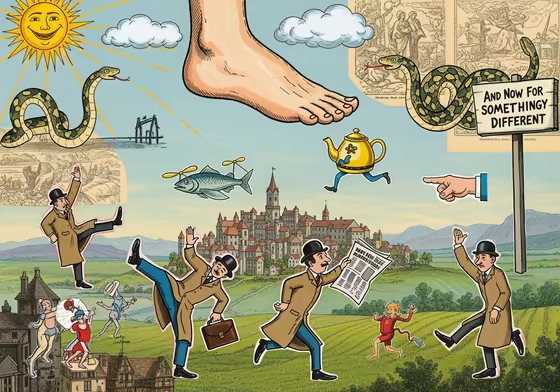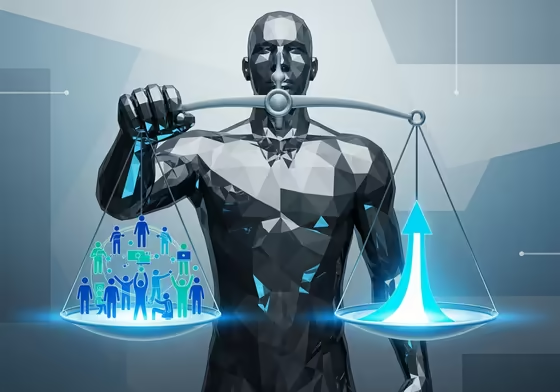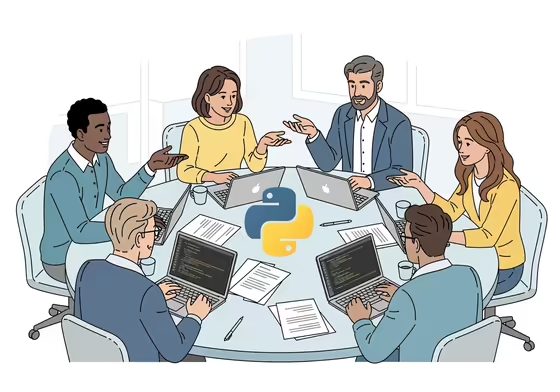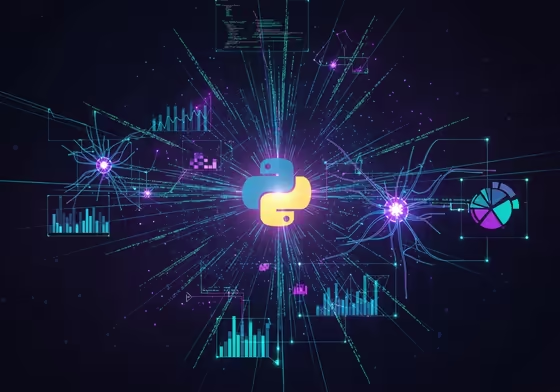Guido van Rossum: The Man Who Made Python
Guido van Rossum is a big name in the computer world. He created the Python programming language. What started as a small hobby project is now used everywhere.
Python is popular in web development, data science, and artificial intelligence. Its success comes from being simple and easy to read. Guido wanted to make a tool that was easy for programmers to use.
His idea was to save people's time, not the computer's time. This made Python a top language for today's technology.
The language has had a huge economic impact around the world, including in Sri Lanka's growing tech industry. It's a key tool for building new things and creating jobs. Python is especially important for Sri Lanka's artificial intelligence and data science fields.
Python is also easy to learn. Its simple style makes it great for teaching people new skills. This article will look at the man, his ideas, and how his creation continues to make a difference.
Who is Guido van Rossum?
Early Life and School
To understand Python, you need to know about the person who made it. Guido van Rossum was born on January 31, 1956, in the Netherlands. He is 69 years old as of 2025.
He went to the University of Amsterdam and was exposed to different programming languages. In 1982, he got his Master's degree in Mathematics and Computer Science.
After school, Guido started working as a programmer at a research center called CWI. This is where the ideas for Python started. He was part of a team working on a language called ABC.

The goal of ABC was to be a simple language to teach programming. It was meant to replace an older language called BASIC. The team wanted to create something better for beginners.
Python was heavily influenced by ABC. For example, using indentation to structure code came from ABC. Guido said he learned a lot from that project.
But ABC had problems. It was a closed system that was hard to add to. It also didn't work well on the smaller computers people had at the time.
So, Guido decided to fix ABC's mistakes. He needed a scripting language for another project he was working on. He wanted something with ABC's simplicity but more practical power.
Python was the result. It combined the easy to read style of ABC with the practical tools of languages like C. It succeeded because it was designed to be open, expandable, and useful.
Common Questions
How to Pronounce His Name
People often ask how to say his name.
- Dutch way: The "G" is a hard sound, like the "ch" in the Scottish word "loch".
- American way: Guido accepts the more common pronunciation: GWEE-doh van ROSS-um.
- About spelling: His last name is two words. The "van" is lowercase when his first name is used, like "Guido van Rossum".
Is He Still Alive?
Yes, Guido van Rossum is alive and well. As of 2025, he is 69 years old. He actively works at Microsoft.
Is He Retired?
No, he is not retired now. He did retire from Dropbox in 2019. But he found retirement boring and joined Microsoft in 2020.
What About His Net Worth or IQ?
There is no public information about his IQ. His net worth is also not public, but some guess it's around $10 million.
It is important to remember his career path. He worked as an employee for companies like Google, Dropbox, and Microsoft. His focus was on building a great open source tool, not on becoming super rich.
How Python Got Started
Why He Made Python
The story of Python starts simply. In 1989, Guido was looking for a hobby project to do over his Christmas break. He decided to create a new scripting language he had been thinking about.
The language was meant to be a successor to ABC. But he wanted it to appeal to programmers who used Unix and C.
He also needed a better tool for his work on a system called Amoeba. He needed a language that was simpler than C but more powerful than basic shell scripts.
Guido saw a gap between two types of programming.
- C gave programmers lots of control, but it was too much work for simple tasks.
- Shell scripts were easy for simple things, but they were too limited for real programming.
Python was designed to be the bridge between these two. It was a real language, but much easier to use than C. You didn't have to worry about managing computer memory yourself.
He later described his goals for Python in a funding proposal.
- An easy language that was still powerful.
- Open source, so anyone could help build it.
- Code that was as easy to read as plain English.
- Good for everyday tasks, with fast development times.
The best thing about Python wasn't a technical feature. It was that it was designed to reduce frustration for the programmer. It was made to be easy to think with.
The goal was to remove "brain friction" so programmers could focus on solving problems. This is why people say Python just "fits in your brain." It lets you write code with fewer lines and less hassle.
The Name and Main Ideas
The Name's Origin
The name "Python" can be confusing, but the story is simple.
- It has nothing to do with snakes.
- When Guido was creating it, he was reading scripts from the comedy show "Monty Python's Flying Circus."
- He wanted a name that was short, unique, and a little mysterious. "Python" was perfect.

Python's Core Beliefs
The language's guiding ideas are written down in a document called "The Zen of Python." It's a list of 19 sayings written by a longtime developer named Tim Peters. The list captures Guido's main principles for the language.
You can see these sayings by typing `import this` into any Python interpreter. Some key ideas are:
- Beautiful is better than ugly.
- Explicit is better than implicit.
- Simple is better than complex.
- Complex is better than complicated.
- Readability counts.
- There should be one and preferably only one obvious way to do it.
- Errors should never pass silently. Unless explicitly silenced.
This philosophy directly shaped how Python's code looks and feels. The most famous example is how Python uses whitespace. You have to indent your code to group it into blocks.
This isn't just for style. It forces the code's visual layout to match its logical structure. This rule helps prevent common bugs that happen in other languages.
In languages like C or Java, the computer reads curly braces {} to understand code blocks. But the human programmer reads the visual indentation. These two things can get out of sync and cause confusion.
Guido got rid of that problem by making indentation the only thing that matters. What you see is what the computer gets. This is a perfect example of the Zen of Python in action.
Table 1: Python's Ideas in Action
| Aphorism (from PEP 20) | Core Principle (Interpretation) | Concrete Syntactical Result in Python |
|---|---|---|
| "Readability counts." | Code is read by humans far more often than it is written. The visual layout must reflect the logical execution. | Mandatory Indentation (Significant Whitespace). This eliminates the ambiguity of brace-based languages where visual and logical blocks can diverge. |
| "Explicit is better than implicit." | "Magic" is bad. The program's behavior, state, and dependencies should be obvious from reading the code. | Explicit self as the first argument in all class methods; import statements are required and do not pollute the global namespace. |
| "Simple is better than complex." | A straightforward, understandable solution is superior to a "clever" but opaque one. | Clean, minimalist syntax. A smaller set of core keywords. A cultural preference against "clever" code, which Van Rossum later championed at Dropbox. |
| "There should be one and preferably only one obvious way to do it." | Avoid multiple, competing ways to perform the same basic operation. This reduces cognitive load on the developer. | The concept of the "Pythonic" way. This principle was also at the heart of the contentious PEP 572 "walrus operator" debate. |
His Career and Impact
His Role: The "Benevolent Dictator"
For almost 30 years, Guido led the Python project with a funny title. He was called the "Benevolent Dictator for Life" or BDFL. This term described his role as the final decision maker.

As the BDFL, Guido provided a clear and consistent vision for the language. This leadership model worked because of a careful balance.
- Benevolent : He earned the community's trust and respect. People believed he would act in the project's best interest.
- Dictator : Having one person make final calls was efficient. It helped avoid endless arguments and kept the project moving forward.
- For Life : This provided stability. It protected the language's core ideas from changing with every new trend.
But this model had a big weakness. As Python grew, having one person in charge became a problem. The role put a huge amount of pressure on Guido, which eventually led to his resignation.
Working at Top Tech Companies
Guido's career shows how Python went from a personal project to a major industry tool. After moving to the U.S. in 1995, he worked for some of the biggest tech companies. These companies were already starting to depend on his creation.
Table 2: Guido van Rossum's Career Path
| Organization | Tenure | Role | Key Projects & Impact |
|---|---|---|---|
| CWI (Netherlands) | 1982-1995 | Researcher / Programmer | Work on ABC Language and Amoeba OS. Invention of Python as a "hobby project". |
| NIST / CNRI (USA) | 1995-2000 | Guest Researcher / Employee | Immigrated to US. Developed Grail, the first Python-based web browser. Wrote the "Computer Programming for Everybody" DARPA proposal. |
| BeOpen / Zope / Elemental | 2000-2005 | Director of PythonLabs / Sr. Lang. Architect | A series of startup and corporate roles, solidifying Python's commercial use cases. |
| 2005-2012 | Senior Staff Engineer | Developed Mondrian (internal) and Rietveld (open-source) code review tools. Contributed to App Engine. Spent 50% of his time on open-source Python language development. | |
| Dropbox | 2013-2019 | Principal Engineer | Led the massive Python 2-to-3 Migration project. Championed and led development of mypy (static typing). Drove a cultural shift away from "cowboy coding". |
| Microsoft | 2020-Present | Distinguished Engineer | Came out of retirement. Leads the "Faster Python" Project, focusing on performance improvements for the core language. |
Working at Google (2005-2012)
At Google, Guido was given a special role. He spent half his time working on the open source Python language. His main project at Google was building a code review system called Mondrian.
This was important. Code review is how large teams make sure their code is readable and easy to maintain. By building Google's tool for this, he was baking Python's philosophy right into the company's culture.
Working at Dropbox (2013-2019)
In 2013, Guido joined Dropbox. The company used Python for almost everything, so it was a good match.
He noticed that some programmers there wrote "cowboy code." It was very clever, but only the person who wrote it could understand it. This kind of code is hard to maintain as a company grows.
Guido helped guide the company toward writing better, more maintainable code. He famously said that "maintainable code is more important than clever code." He led major projects to improve the stability and consistency of Dropbox's code.
Working at Microsoft (2020-Present)
So, what is he doing now? After a brief retirement, Guido joined Microsoft in 2020. His goal is to make Python better for everyone. His team is focused on the "Faster Python" project to improve the language's speed.
Python's Legacy and Future
Why He Stepped Down
On July 12, 2018, Guido van Rossum made a big announcement. He was stepping down as the "Benevolent Dictator for Life," effective immediately.
The final straw was a difficult debate over a new feature. The feature was called the "walrus operator" because `:=` looks like a walrus.
The debate was intense.
- Supporters thought it was a nice shortcut for certain coding patterns.
- Opponents argued it made code harder to read. They said it went against Python's core belief in simplicity.
Guido made the final call and approved the new feature. The negative reaction from parts of the community was very strong.
He explained in an email that he was tired of fighting so hard for his decisions. He decided to remove himself from the decision making process for good.
But the real reason was that Python had become too big for one person to lead. The BDFL model didn't work anymore. The stakes were too high, and the role had become a huge personal burden.
By stepping down without naming a replacement, he forced the community to grow up. He made them create a new, more democratic way to govern the language for the future.
Who Runs Python Now?
So who runs Python today? After Guido resigned, the core developers voted on a new leadership model.

They chose to create a Steering Council. This new system is described in an official document, PEP 13.
- Python is now led by a 5-person Steering Council.
- The council members are elected every year by the core developers.
- Their job is to maintain the language's quality and stability. They also make the final decisions on new features.
Table 3: How Python's Leadership Changed
| Governance Aspect | BDFL Model (Pre-2018) | Steering Council Model (Post-2018, per PEP 13) |
|---|---|---|
| Ultimate Authority | A single person: Guido van Rossum, the BDFL. | A 5-person elected committee: The Steering Council. |
| Decision Process | BDFL's final judgment, after community discussion. | Formal consensus-seeking and voting process by the Council. |
| Selection of Leader(s) | "Benevolent Dictator for Life ". | Annual elections by the "core team" of developers. |
| GvR's Formal Role | The BDFL: Project leader and final arbiter. | None. He is an "ordinary core dev," mentor, and Microsoft employee. |
Guido is no longer the leader, but he is still an active contributor. He was elected to the very first Steering Council but stepped away from governance after that. He now contributes through his work at Microsoft and by mentoring other developers.
Python's Lasting Impact
Global Impact: How Python Took Over AI
Today, Python is one of the most popular programming languages in the world. Its biggest impact has been in Artificial Intelligence (AI) and Machine Learning (ML). This was a surprise even to Guido.

Python is the top language for data science and AI. This happened for a few key reasons.
- It's Simple: Python's easy to read style is great for scientists and researchers. They can test complex ideas without getting stuck on difficult syntax.
- Great Libraries: The community has built amazing tools for AI and data. Libraries like NumPy, Pandas, and TensorFlow form the backbone of modern machine learning.
This success is a perfect example of Guido's original vision. He wanted to build a "bridge" or "glue" language. He wanted something easy to use that could connect to other, more powerful systems.
The field of AI has the same need. It requires both fast performance for math and an easy language for researchers to experiment.
Python is that bridge. Researchers write simple Python code that calls on powerful, high performance libraries to do the heavy lifting. Python's design made it the perfect tool for the job.
Local Impact: Python in Sri Lanka
This global success has a real impact in places like Sri Lanka. The country's tech industry is growing fast, and Python is helping to drive that growth.
- Industry Use: Sri Lankan tech companies use Python for web development, software, and data projects. The country is becoming a hub for AI, a field that relies heavily on Python.
-
Education:
To support this growth, major universities offer Python courses. This helps build a skilled workforce for the tech industry.
- The University of Moratuwa has online Python classes.
- SLIIT offers a certificate program in Python programming.
- The Open University of Sri Lanka has a short course for beginners.
- The University of Sri Jayewardenepura offers a certificate in using Python for AI.
- Community: Active developer groups like the Sri Lanka Python User Group also support the ecosystem. They host events and workshops for programmers.
As a final fun fact, the Python logo was not inspired by the comedy show. The two snakes were designed by Tim Parkin. But the "Python Powered" font was designed by Guido's brother, Just van Rossum.
In the end, Guido van Rossum's idea for a simple language has helped millions of people. The hobby project he started in 1989 has become a major force in technology. His vision now creates jobs and helps people in places like Sri Lanka build the future.